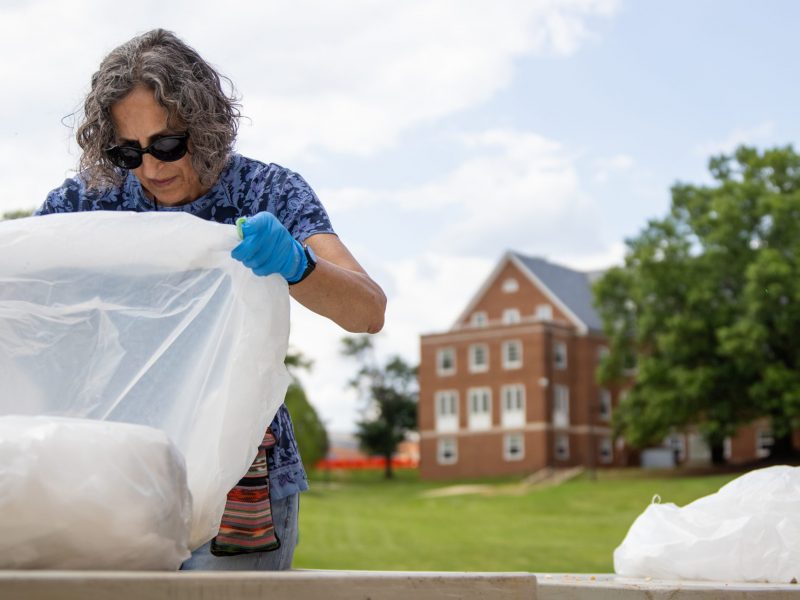
Earth Day volunteers Heather Stangle (left) and Molly Amalia (center) dressed as a tree and a Dr. Suess’ Lorax to raise awareness. Students and visitors were allowed to pet three Diamondback terrapins during the event.
Only 30 yards away from dozens of undergraduates sunbathing in skimpy summer garb and throwing Frisbees on McKeldin Mall, Dr. Seuss’ Lorax had jumped straight off his technicolor pages and onto the campus.
With its distinctive neon orange fur and yellow mustache, the Lorax roamed through a crowd, smiling at a group of girls cooing over an aquarium of baby Diamondback terrapins while their boyfriends devoured Sno-Kones and cotton candy, waiting in line for their turn on the moonbounce and in the dunk tank.
This scene isn’t one from a lost Seuss story where the Lorax and an all-American carnival collide. Instead, as a variety of student groups and local organizations came to promote Earth Day and raise awareness about the Diamondback terrapin, McKeldin Mall was transformed Thursday into an environmental bonanza.
Although Earth Day is this Saturday, April 22, several student groups held the festival yesterday to promote awareness about the decreasing number of Diamondback terrapins, this university’s mascot and the state reptile. Through the fair, organizers hoped to encourage students to help Save the Terrapin, an effort headed by the Terrapin Institute, a local charity dedicated to the animals’ conservation.
Funds for terrapin research and conservation efforts come from a variety of sources across the state, but on the campus, students indirectly aid the cause by buying “Fear the Turtle” merchandise, which donates a portion of its proceeds to the Department of Natural Resources.
More important, however, is the direct aid the university contributes. While the university has donated up to $10,000 to the institute in the past and gave $6,000 last year, they only dedicated $1,000 this year, a significant drop that caused the organization to look to raise awareness among the university’s students instead of its administration, said Marguerite Whilden, founder and co-director of the institute.
“We’re just focused on the species and its habitat,” she said. “We find students have always been very responsive. Who doesn’t love a turtle?”
Diamondback terrapins used to be plentiful in the Chesapeake Bay during the last century because of its ideal brackish water. Since then their population has fallen as seafood dealers take advantage of the state’s nine-month harvest season to catch and kill thousands of pounds of terrapins, according to Whilden. Because no legislation to ban the harvest has succeeded yet, it is up to the institute and other organizations to keep pushing for restrictions, Whilden added.
At first, the student groups – led by the College Park Environmental Group and MaryPIRG – wanted to raise money during the fair by selling $10 T-shirts and then donating that money to the institute. But because CPEG and MaryPIRG used funds from the Student Government Association to organize the fair, they could not donate money raised at the event to organizations outside of the university, said David Sachs, a senior mechanical engineering major and co-chair of the event’s planning committee.
“The money would have been nice to raise to give to them, but just getting the word out and making people appreciate the terrapin is the biggest issue,” he said. “Not everyone has to be a crazy activist. The most important thing is just to … make the environment a better place.”
At the event Thursday, girls giggled as they picked up and kissed the shells of the three full-grown terrapins Whilden had brought with her.
“Since we have [the terrapins] here with their babies – everyone loves babies – it’s a more hands-on experience than just putting up posters,” said the Lorax – or Amalia Pleake-Tamm, a senior environmental science and policy and English major, dressed in an orange felt costume.
Pleake-Tamm dressed as the Lorax, Dr. Seuss’ “mossy, bossy” creature who speaks for the trees against greedy industrialists, to send an indirect message to her fellow students about preserving the environment.
Junior environmental science and policy and government and politics major Tama Griffith swooned over the diamondbacks like everyone else, but was hesitant to predict whether their efforts would successfully encourage anyone to save the terrapins.
“I think they’re good for cute value,” Griffith said. “But I don’t think anybody [at the university] cares about anything. We don’t ever follow through.”
However, event organizer Zoe Paterson thinks that if students pushed the administration, they would consider increasing their support to the institute, she said.
“Letting people know what’s going on with terrapins [is necessary because] if people are aware, they’ll think it’s important because it’s our mascot,” she said. “And if the students put pressure on the administration, they’ll know we’re aware.”
Aside from stressing the importance of saving the terrapins, the Earth Day festivities also promoted recycling on the campus, Sachs said. Thanks to a successful bill sponsored by Sen. John Giannetti (D-Prince George’s County) the state recently gave the university $32,000 for recycling bins to be placed around McKeldin Mall, Stamp Student Union and Fraternity Row.
The program was enacted five weeks ago, Sachs said, and drew Giannetti to the campus. The senator also spoke Thursday morning on the mall.
Although the organizers used the combination of appearances by local politicians, the cuteness of the baby terrapins and the free sugary confections to draw their peers, Sachs said he hopes students will recognize and rally behind the real message of Earth Day.
“People can come and eat sno-cones and cotton candy, but the biggest part and most important part is getting people involved,” he said. “And we’ll see if they will be.”
Contact reporter Roxana Hadadi at roxanadbk@gmail.com.



